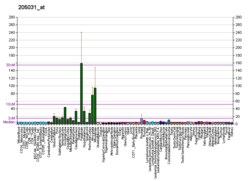
Summary
Ephrin-B3 is a protein that in humans is encoded by the EFNB3 gene.[5][6]
| EFNB3 | |||||||||||||||||||||||||||||||||||||||||||||||||||
|---|---|---|---|---|---|---|---|---|---|---|---|---|---|---|---|---|---|---|---|---|---|---|---|---|---|---|---|---|---|---|---|---|---|---|---|---|---|---|---|---|---|---|---|---|---|---|---|---|---|---|---|
| |||||||||||||||||||||||||||||||||||||||||||||||||||
| Identifiers | |||||||||||||||||||||||||||||||||||||||||||||||||||
| Aliases | EFNB3, EFL6, EPLG8, LERK8, ephrin B3 | ||||||||||||||||||||||||||||||||||||||||||||||||||
| External IDs | OMIM: 602297 MGI: 109196 HomoloGene: 1076 GeneCards: EFNB3 | ||||||||||||||||||||||||||||||||||||||||||||||||||
| |||||||||||||||||||||||||||||||||||||||||||||||||||
| |||||||||||||||||||||||||||||||||||||||||||||||||||
| |||||||||||||||||||||||||||||||||||||||||||||||||||
| |||||||||||||||||||||||||||||||||||||||||||||||||||
| |||||||||||||||||||||||||||||||||||||||||||||||||||
| Wikidata | |||||||||||||||||||||||||||||||||||||||||||||||||||
| |||||||||||||||||||||||||||||||||||||||||||||||||||
EFNB3, a member of the ephrin gene family, is important in brain development as well as in its maintenance. The EPH and EPH-related receptors comprise the largest subfamily of receptor protein-tyrosine kinases. EPH receptors typically have a single kinase domain and an extracellular region containing a Cysteine-rich domain and 2 fibronectin type III repeats. The ephrin ligands and receptors have been named by the Eph Nomenclature Committee (1997) based on their structures and sequence relationships. Ephrins are divided into the ephrin-A (EFNA) class, which are anchored to the membrane by a glycosylphosphatidylinositol linkage, and the ephrin-B (EFNB) class, which are transmembrane proteins. Ephrin-B ligands also contain an intracellular tail with highly conserved tyrosine residues and a PDZ-binding motif at the C-terminus.[7] This tail functions as a mechanism for reverse signaling, where signaling occurs into the ligand-containing cell, as opposed to the cell with the receptor. Upon receptor-ligand interaction the tyrosine residues become phosphorylated and there is recruitment of PDZ domain-containing proteins.[7] The Eph family of receptors are similarly divided into two groups based on the similarity of their extracellular domain sequences and their affinities for binding ephrin-A and ephrin-B ligands.[6] EphrinB3 has been implicated in mediating various developmental events, particularly in the nervous system. EphrinB3 reverse signaling is important for axon pruning and synapse and spine formation during postnatal development of the nervous system.[8][9] Previous work has also shown that signaling through this ligand is important for radial migration during cortical development.[8] Moreover, levels of EFNB3 expression are particularly high in several forebrain subregions compared to other brain subregions, and may play a pivotal role in forebrain function. It has been suggested that ephrinB3 signaling is necessary for synaptic plasticity to occur in the hippocampus; this implicates ephrinB3 as a major player in learning and memory.[9] More recently, ephrinB3 has been shown to regulate proliferation of neural stem cells in the adult subventricular zone (SVZ).[8][10]
References edit
- ^ a b c GRCh38: Ensembl release 89: ENSG00000108947 – Ensembl, May 2017
- ^ a b c GRCm38: Ensembl release 89: ENSMUSG00000003934 – Ensembl, May 2017
- ^ "Human PubMed Reference:". National Center for Biotechnology Information, U.S. National Library of Medicine.
- ^ "Mouse PubMed Reference:". National Center for Biotechnology Information, U.S. National Library of Medicine.
- ^ Tang XX, Pleasure DE, Ikegaki N (May 1997). "cDNA cloning, chromosomal localization, and expression pattern of EPLG8, a new member of the EPLG gene family encoding ligands of EPH-related protein-tyrosine kinase receptors". Genomics. 41 (1): 17–24. doi:10.1006/geno.1997.4615. PMID 9126477.
- ^ a b "Entrez Gene: EFNB3 ephrin-B3".
- ^ a b Klein, Rudiger (November 15, 2012). "Eph/ephrin signalling during development". Development. 139 (22): 4105–9. doi:10.1242/dev.074997. PMID 23093422.
- ^ a b c Rodger, Jennifer; Lorena Salvatore; Paolo Migani (2012). "Should I Stay or Should I Go? Ephs and Ephrins in Neuronal Migration". Neurosignals. 20 (3): 190–201. doi:10.1159/000333784. PMID 22456188.
- ^ a b Hruska, Martin; Matthew B. Dalva (2012). "Ephrin regulation of synapse formation, function and plasticity". Molecular and Cellular Neuroscience. 50 (1): 35–44. doi:10.1016/j.mcn.2012.03.004. PMC 3631567. PMID 22449939.
- ^ Ricard, Jerome; Jessica Salinas; Lissette Garcia; Daniel J. Liebl (2006). "EphrinB3 regulates cell proliferation and survival in adult neurogenesis". Molecular and Cellular Neuroscience. 31 (4): 713–22. doi:10.1016/j.mcn.2006.01.002. PMID 16483793. S2CID 206830930.
Further reading edit
- Flanagan JG, Vanderhaeghen P (1998). "The ephrins and Eph receptors in neural development". Annu. Rev. Neurosci. 21: 309–45. doi:10.1146/annurev.neuro.21.1.309. PMID 9530499.
- Zhou R (1998). "The Eph family receptors and ligands". Pharmacol. Ther. 77 (3): 151–81. doi:10.1016/S0163-7258(97)00112-5. PMID 9576626.
- Holder N, Klein R (1999). "Eph receptors and ephrins: effectors of morphogenesis". Development. 126 (10): 2033–44. doi:10.1242/dev.126.10.2033. PMID 10207129.
- Wilkinson DG (2000). "Eph receptors and ephrins: regulators of guidance and assembly". Int. Rev. Cytol. International Review of Cytology. 196: 177–244. doi:10.1016/S0074-7696(00)96005-4. ISBN 978-0-12-364600-2. PMID 10730216.
- Xu Q, Mellitzer G, Wilkinson DG (2001). "Roles of Eph receptors and ephrins in segmental patterning". Philos. Trans. R. Soc. Lond. B Biol. Sci. 355 (1399): 993–1002. doi:10.1098/rstb.2000.0635. PMC 1692797. PMID 11128993.
- Wilkinson DG (2001). "Multiple roles of EPH receptors and ephrins in neural development". Nat. Rev. Neurosci. 2 (3): 155–64. doi:10.1038/35058515. PMID 11256076. S2CID 205014301.
- Gale NW, Flenniken A, Compton DC, et al. (1996). "Elk-L3, a novel transmembrane ligand for the Eph family of receptor tyrosine kinases, expressed in embryonic floor plate, roof plate and hindbrain segments". Oncogene. 13 (6): 1343–52. PMID 8808709.
- Ephnomenclaturecommittee (1997). "Unified nomenclature for Eph family receptors and their ligands, the ephrins. Eph Nomenclature Committee". Cell. 90 (3): 403–4. doi:10.1016/S0092-8674(00)80500-0. PMID 9267020. S2CID 26773768.
- Bergemann AD, Zhang L, Chiang MK, et al. (1998). "Ephrin-B3, a ligand for the receptor EphB3, expressed at the midline of the developing neural tube". Oncogene. 16 (4): 471–80. doi:10.1038/sj.onc.1201557. PMID 9484836.
- Brückner K, Pablo Labrador J, Scheiffele P, et al. (1999). "EphrinB ligands recruit GRIP family PDZ adaptor proteins into raft membrane microdomains". Neuron. 22 (3): 511–24. doi:10.1016/S0896-6273(00)80706-0. PMID 10197531.
- Liu W, Ahmad SA, Jung YD, et al. (2002). "Coexpression of ephrin-Bs and their receptors in colon carcinoma". Cancer. 94 (4): 934–9. doi:10.1002/cncr.10122. PMID 11920461. S2CID 25734266.
- Takemoto M, Fukuda T, Sonoda R, et al. (2002). "Ephrin-B3-EphA4 interactions regulate the growth of specific thalamocortical axon populations in vitro". Eur. J. Neurosci. 16 (6): 1168–72. doi:10.1046/j.1460-9568.2002.02166.x. PMID 12383247. S2CID 7540058.
- Strausberg RL, Feingold EA, Grouse LH, et al. (2003). "Generation and initial analysis of more than 15,000 full-length human and mouse cDNA sequences". Proc. Natl. Acad. Sci. U.S.A. 99 (26): 16899–903. Bibcode:2002PNAS...9916899M. doi:10.1073/pnas.242603899. PMC 139241. PMID 12477932.








